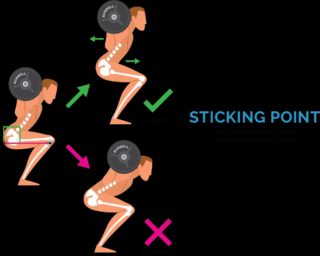
We recently posted to IG about training through sticking points. Particularly, it was about the Spoto press, which has been our bench press variation this strength cycle. In this lift, the lifter stops the bar about an inch above their chest. It’s a great movement for training the low sticking point in the bench press.
What is a sticking point? Simply put, it’s where a lifter gets stuck during a lift (we’re talking about presses, squats, and deadlifts here. The Olympic lifts are a slightly different animal). Sometimes we’re able to grind through the sticking point and complete the lift, and sometimes it causes us to fail.
Sticking points occur for a few reasons. First, sticking points occur when we are at a mechanical disadvantage. Everyone’s limbs are different lengths, and our limbs create levers. Generally speaking, the longer the limb, the more difficult the lift. Position helps in this regard – when we lift, we try to position ourselves to maximize our leverages. When performing a shoulder press, for example, the angle of our arms, and the inclination of our torso creates an inherent disadvantage when the barbell is at the same level as our face. By maintaining proper position, we can minimize the amount we lean back, which keeps the bar as close to our midline as possible. In turn, this minimizes the mechanical disadvantage. We can never completely overcome the issue, but we can practice our movement patterns and hammer out our technique to minimize the effect of it.
Along the same lines, sticking points can occur when we use poor technique. This typically occurs when we transition from the negative portion of a lift to the positive portion of a lift. In the bench press, for example, we often see members look solid as they lower the weight down. Then, after bouncing it off their chest, they struggle with elbows flaring out to the sides, and may or may not be successful lifting the weight. When we bounce the weight, we lose stability. When our elbows flare, we’re not engaging our lats. And when we allow this kind of technical breakdown, it makes it harder to engage the correct muscles to complete the lift. So, if the issue is truly form related, practicing the lift correctly will help us fix it.
In some instances, however, we lose form because the weight is too heavy for us. And this brings us to our last reason for sticking points – lagging muscle groups. As we move through a lift and our leverages change, different muscles dominate the lift. Going back to the bench press, lifters tend to miss in 1 of three areas: immediately off the chest, halfway up, or at the lockout. When a lifter misses immediately off the chest, it’s because their upper back is not strong enough to maintain solid posture, and their stable base collapses. At the half-way point, the weight transfers from your upper back and arms to the front of your shoulder and arms. Lifters who miss here need direct arm and shoulder work. Finally, your triceps are responsible for the lockout in the bench press. Lifters who miss here need to hammer their triceps.
We can assess lagging muscle groups by watching our lifts. If a lifter is technically sound until they reach heavy weights, then we know the issue is muscular, and not technical. And by assessing where an athlete gets stuck in a lift, we can figure out what muscles are lagging, and program accordingly to strengthen those muscles. This brings us back to the Spoto press. Since it forces us to pause right above our chests, it prevents us from bouncing the bar, and ensures that we maintain proper posture at the bottom of our lift. It is a drill to strengthen our shoulders in the bottom position to hopefully get rid of that sticking point. We use this approach with all our main lifts – it’s why we use box squats frequently too. Anytime we program a variation of a main lift, using pauses, tempo, or shortening the range of motion with a box (or the floor), it is with the goal of fixing our sticking points. And, we program accessory days to strengthen lagging muscle groups as well. Our “swole days” may help with aesthetics, but mostly they’re about helping you lift better. See you in the gym.
